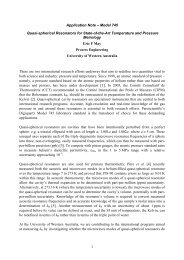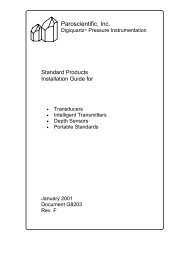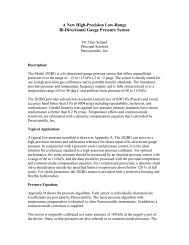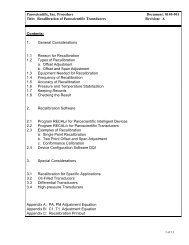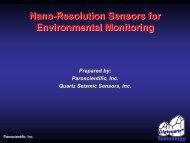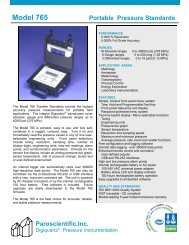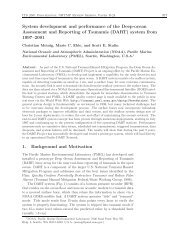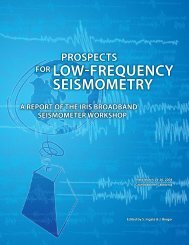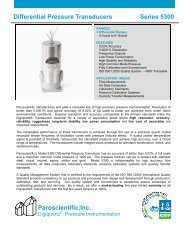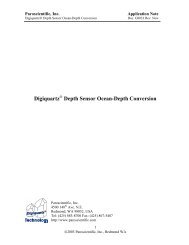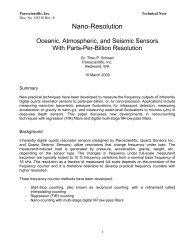Navigation is Key to AUV Missions - Paroscientific, Inc.
Navigation is Key to AUV Missions - Paroscientific, Inc.
Navigation is Key to AUV Missions - Paroscientific, Inc.
Create successful ePaper yourself
Turn your PDF publications into a flip-book with our unique Google optimized e-Paper software.
“Position calibration of the <strong>AUV</strong> on the seafloor may be performed<br />
with a single seafloor transponder of use a vesselbased<br />
USBL.”<br />
replace.<br />
RD Instruments has installed its<br />
Workhorse DVLs on more than 90<br />
percent of the world <strong>AUV</strong> fleet and on<br />
over 100 ROVs. /st/<br />
gation system while the ship maneuvers<br />
in a slow circle for up <strong>to</strong> 20 minutes.<br />
When the <strong>AUV</strong> <strong>is</strong> descending, the<br />
INS <strong>is</strong> in barometer-aided mode and<br />
uses the Digiquartz <strong>to</strong> sense depth.<br />
The USBL system may also be used <strong>to</strong><br />
track the vehicle, with updates made<br />
by the shipboard navigation computer<br />
telemetered <strong>to</strong> the <strong>AUV</strong>. On arrival at<br />
the seafloor the RDI DVL bot<strong>to</strong>mlocks<br />
and begins providing velocity<br />
data <strong>to</strong> the <strong>AUV</strong> navigation system.<br />
Data acqu<strong>is</strong>ition now begins with<br />
time, position, velocity, heading and<br />
attitude data provided <strong>to</strong> the vehicle<br />
control computer for both guidance<br />
and control. When the vehicle ascends<br />
the same procedure as for descent <strong>is</strong><br />
followed and once on the surface the<br />
GPS system <strong>is</strong> used <strong>to</strong> bring ship and<br />
vehicle <strong>to</strong>gether.<br />
The Boeing/Fugro/Oceaneering<br />
vehicle’s navigation system <strong>is</strong> based<br />
on the full integration of all available<br />
sensors including INS, a hybrid RDI<br />
DVL, altimeter, depth, LBL and<br />
USBL. Inputs in<strong>to</strong> th<strong>is</strong> Kalman filter<br />
can include roll, pitch, heading, vehicle<br />
accelerations, vehicle velocity,<br />
height above seafloor, depth, ranges <strong>to</strong><br />
transponders on the seafloor or USBL<br />
data from a vessel at the surface.<br />
Position calibration of the <strong>AUV</strong> on the<br />
seafloor may be performed with a single<br />
seafloor transponder of use a vessel-based<br />
USBL.<br />
What all four of these main contenders<br />
in the commercial <strong>AUV</strong> business<br />
have in common <strong>is</strong> the RD<br />
Instruments doppler velocity log. Th<strong>is</strong><br />
measures velocity relative <strong>to</strong> the<br />
seafloor and altitude over the seafloor.<br />
It uses four beams at 30° from the vertical<br />
in convex configuration <strong>to</strong> insonify<br />
the seafloor and measures the<br />
doppler shift of the return. Th<strong>is</strong> shift <strong>is</strong><br />
then converted on<strong>to</strong> an accurate velocity<br />
vec<strong>to</strong>r.<br />
RDI systems for the Racal,<br />
Boeing/Fugro/Oceaneering and C&C<br />
<strong>AUV</strong>s are 600 kilohertz versions with<br />
a minimum range of 0.7 meter and<br />
maximum of 90 meters and with an<br />
accuracy of ±0.2 percent at 1 millimeter<br />
per sec - around 0.004m/sec at<br />
three knots. The Maridan RDI DVL <strong>is</strong><br />
a 1,200 kilohertz instrument. A further<br />
instrument in the standard RDI<br />
Workhorse Naviga<strong>to</strong>r DVL range<br />
operates at 300 kilohertz. Across the<br />
range, therefore, the DVLs operate<br />
between 0.5 meters and 200 meters<br />
above the seafloor with a depth rating<br />
of 2,000 meters standard, 6,000 meters<br />
optional.<br />
Cus<strong>to</strong>mized units are also produced<br />
—a recent example <strong>is</strong> for a number of<br />
specialized systems for Coastal<br />
Systems Station (CSS) in Panama<br />
City, Florida. These <strong>to</strong>ok the place of<br />
four competing systems that did not<br />
meet requirements on CSS <strong>AUV</strong>s,<br />
with the RDI DVL noted in the<br />
Commerce Business Daily bulletin as<br />
“the only unit proven <strong>to</strong> meet all operational<br />
requirements.” RDI reconfigured<br />
its smaller DVL <strong>to</strong> fit in the footprint<br />
of the competing model, <strong>to</strong> suit<br />
the retrofit requirements. RDI’s navigation<br />
device <strong>is</strong> not only smaller but<br />
also less expensive than the original<br />
equipment.<br />
The CSS experience with RDI’s<br />
DVLs led it <strong>to</strong> recommend them <strong>to</strong><br />
Boeing Company, which was experiencing<br />
similar problems with a navigation<br />
system on its Long-term Mine<br />
Reconna<strong>is</strong>sance System (LMRS)<br />
under development by Boeing for the<br />
U.S. Navy. Th<strong>is</strong> <strong>is</strong> an unmanned surveillance<br />
system that provides a clandestine<br />
capability <strong>to</strong> determine the<br />
ex<strong>is</strong>tence of mines in potential threat<br />
environments.<br />
Boeing was having problems with<br />
the ex<strong>is</strong>ting navigation units on the<br />
LMRS—they easily lost bot<strong>to</strong>m track<br />
and were slow <strong>to</strong> reacquire it. The U.S.<br />
Navy’s Coastal Systems Station,<br />
Florida, (CSS) had also had problems<br />
with the same units on its own underwater<br />
vehicles and had replaced them<br />
with RDI. These performed well and<br />
CSS recommended Boeing <strong>to</strong> make<br />
the same replacement on the LMRS.<br />
The RDI cus<strong>to</strong>mized DVLs use<br />
broadband bot<strong>to</strong>m track technology <strong>to</strong><br />
give a unit that <strong>is</strong> smaller, more accurate<br />
(0.2 percent of depth) and which<br />
reacquire bot<strong>to</strong>m track far more quickly<br />
than the narrow band units they<br />
John Romeo has worked on the development<br />
of a wide range of RD Instruments<br />
products for the past 14 years. He has a<br />
formal background in manufacturing engineering<br />
along with international business<br />
and marketing. He <strong>is</strong> navigation business<br />
unit manager for RD Instruments.<br />
Graham Lester <strong>is</strong> RD Instruments’ technical<br />
sales manager for the <strong>Navigation</strong><br />
Business Unit. He applies h<strong>is</strong> market<br />
development knowledge <strong>to</strong> underwater<br />
navigation based on h<strong>is</strong> background in<br />
avionics and h<strong>is</strong> experience in marine survey<br />
systems.



